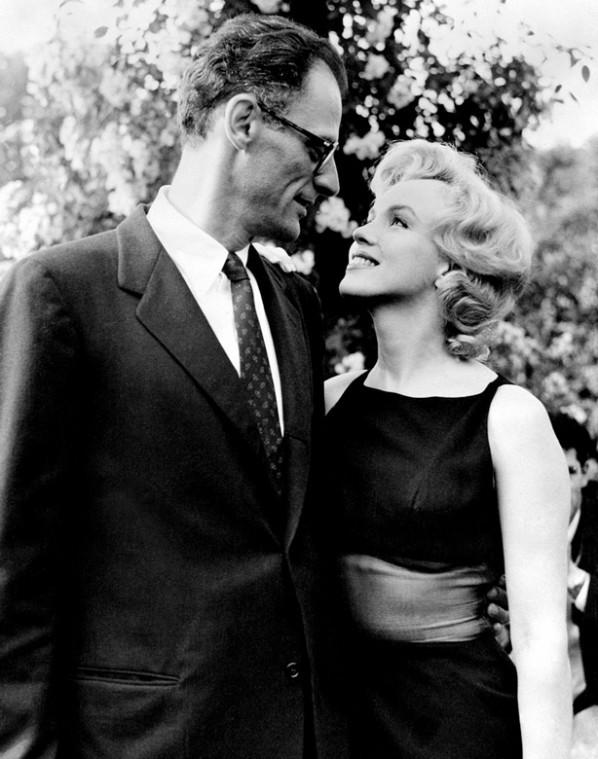Cohnipedia: Miller and Marilyn: a not so odd Jewish couple
Published December 15, 2011
“My Week With Marilyn,” which has received mostly positive reviews, stars Michelle Williams in the tile role, where she practically “channels” the iconic blonde bombshell of the silver screen.
The film is based on a memoir by a second assistant to Laurence Olivier (Kenneth Branagh) who is directing the film version of “The Prince and the Showgirl,” in which he, the Prince, who had triumphed as Prince Hamlet, is captivated by an American showgirl, played by Marilyn Monroe.
So where is the “Jewish angle” making Marilyn Monroe worthy of inclusion in a “Cohnipedia” column, you might ask?
First is the fact that at the time of the filming of “The Prince and the Showgirl” in 1956, Marilyn Monroe was in the first year of her ultimately doomed marriage to Arthur Miller. He was, of course, the Jewish Pulitzer Prize winning playwright of such classic plays as “Death of a Salesman,” whose title character, Willy Loman, was believed to be Jewish even though his ethnicity is never explicitly identified in the script.
Miller, who died in 2005 at the age of 89, was born Oct. 17, 1915, in Harlem, N.Y., the second of three children of Isidore and Augusta Miller, Polish-Jewish immigrants. Like Joe DiMaggio before him, Miller was completely smitten by Monroe, who despite her “dumb blonde” persona in many of her roles, was actually quite intelligent and a graduate of the Actors Studio, along with Marlon Brando, Paul Newman, and Dustin Hoffman. Monroe fully requited Miller’s love, and became a Jew by choice under the supervision of Rabbi Robert E. Goldburg, who signed her official Certificate of Conversion on July 1, 1956. Her conversion pleased Miller’s parents and siblings at the time, and even after her divorce, she continued to identify herself as “Jewish.” Among her prized possessions was a Hanukkah menorah that played “Hatikva,” Israel’s national anthem, an item that fetched a tidy sum when auctioned off by Christie’s in New York in 1999.
By the time of the filming of “The Prince and the Showgirl,” the personal demons that afflicted Monroe were already apparent. Her addictions to alcohol and various medications were already taking their toll on the mega-star-afflictions which would eventually contribute to her death of an apparent overdose in 1962.
Miller was eventually driven to distraction by Monroe, and the couple divorced in 1961. But she continued to haunt him for the rest of his personal and creative life.
Monroe’s last film, in which she co-starred with Clark Gable in his last film, was “The Misfits” (1960), for which Miller wrote the screenplay. Hollywood legend has it that Gable was so stressed by his efforts to keep Monroe focused, that he died after the film’s release. Miller would describe the period of the filming of “The Misfits” as “one of the lowest points in his life.” Shortly before the film’s premiere in 1961, Miller and Monroe divorced; 19 months later, Marilyn was dead of what the coroner officially ruled “an apparent overdose.”
Miller’s play “After the Fall,” which was first produced n 1964, was described as “a deeply personal view of Miller’s experiences during his marriage to Monroe.” The male lead, Quentin, is based on Miller himself, while his disturbed, pill-popping wife, Maggie, was obviously a thinly disguised Monroe.
I had two opportunities to interview Arthur Miller, who I had regarded as a hero since I saw the film version of “Death of a Salesman.” Miller was in St. Louis in 1980, when he received that year’s Wilma and Roswell Messing, Jr. Award from the Associates of St. Louis University. I had a brief time with Miller after his talk, and asked him, “In your mind, did you identify Willy Loman as a specifically Jewish character, or did you intend Willy to be a universal character?”
Miller said, “Yes, he was a Jewish character in my mind. But he is a lot of other things. In some ways he is. In some ways he isn’t. But in my mind, he was exactly what I said to you.” He noted that “Death of a Saleman” has been well-received in many nations around the world, “and people draw universal application from the particulars.”
I next had the opportunity to do a more extensive interview with Miller by phone in 2000, during the period when “Death of a Salesman” was marking its 50th anniversary. One of its scheduled appearances was at the Fox Theatre where actor Brian Dennehy did a superb job of portraying Willy Loman. By that time, Miller had published “Timebends,” his lengthy autobiography in which he confirmed that the inspiration for Loman was a composite of various real-life salespeople, including his “Uncle Manny,” all of whom were Jewish.
Miller was relaxed and friendly throughout the interview, but he politely and firmly declined to comment on his marriage to Monroe. “Bob, it’s all in my book, ‘Timebends,’ and there is nothing more that I wish to add about that part of my life.”
Miller would have one more thing to “add about that part” of his life: his very last play, “Finishing the Picture” was based on the filming of “The Misfits,” and how Monroe managed to drive everyone associated with the project to distraction. After viewing “My Week With Marilyn,” in which Michelle Williams brought back to the screen the beauty, brilliance, fragility and torment of Marilyn Monroe vividly back to life, I could more clearly understand why Arthur Miller did not want to talk about it any more.
















